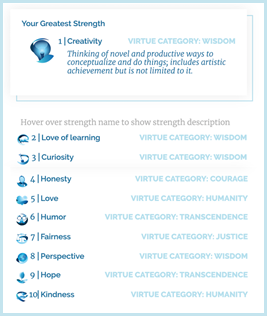03 Feb Becoming a Project Motivator: Introducing Strengths-based Project Management
Becoming a Project Motivator: Introducing Strengths-based Project Management
What inspires your team to come to the office, work hard, and pursue excellence when facing countless obstacles? Sure, we all want (and need) a paycheck, but science tells us that external rewards usually aren’t enough to help us become the best version of ourselves.
Employees need something more…
We love sharing project management tech tools on our blog, but in this post, we’d like to focus on a set of tools that are just as valuable—and often overlooked. Today, we’re going to explore how you can maximize potential by tapping into your own strengths and helping your colleagues tap into theirs.
This blog post will cover…
What is Strengths-based Project Management (SBPM)?
6 Stages of SBPM (how it works)
1. Understanding your own strengths
2. Cultivating your own character strengths
3. Modeling your character strengths
4. Seeking and seeing the character strengths of others
5. Highlighting and acknowledging character strengths of others
6. Leveraging the strengths of the team to make the project work
Note: Feel free to skip ahead by clicking on any of the links above.
What is Strengths-based Project Management (SBPM)?
Strengths-based Project Management (SBPM) is an approach to project management that maximizes individual and organizational potential by focusing on, and developing, employees’ strongest attributes. Heavily influenced by the field of Positive Psychology—which is all about studying mentally healthy people—SBPM works to change our natural human tendency to focus on our defects while ignoring our strengths.
Ruth Pearce, author of Strengths-based Project Management and creator of the methodology, writes “[Our Negativity bias] is natural and sometimes hard to resist, and yet research shows that focusing on negatives narrows our gaze and our thinking, and that focusing on positives makes us more creative, more open to other positive ideas and experiences, and more likely to innovate and solve problems.”
Pearce goes on to explain that a strengths-based approach doesn’t ignore weaknesses, and her book goes into great detail about solving deficits. However, she encourages us to give the positive more attention than we’re naturally inclined to give it, helping employees embrace their strongest attributes.
The result? Greater employee engagement and motivation. “Motivated people are energized people,” writes Pearce. “Energized people make things happen.”
6 Stages of SBPM (how it works)
SBPM is about going from a project manager to a “project motivator,” and just as everyone plays a role in helping projects move toward completion, anyone can help motivate those around them.
Pearce has identified the following six stages for adopting a strengths-based approach:
1. Understanding your own strengths
2. Cultivating your own character strengths
3. Modeling your character strengths
4. Seeking and seeing the character strengths of others
5. Highlighting and acknowledging character strengths of others
6. Leveraging the strengths of the team to make the project work
Let’s explore each of these in a little more depth.

Stage 1: Understanding your own strengths
Strengths-based Project Management starts with getting to know your own strengths. If you have 10 minutes right now, hop over to ViaCharacter.org and take the free assessment to identify your strongest attributes. If you don’t have time now, bookmark it and take the test when you can. Trust us, it’s worth it.
The test identifies 24 different strengths (such as leadership, prudence, self-regulation, and love of learning), and it ranks them from strongest to least strong. Figuring out what you’re good at, as well as acknowledging those things at the bottom that aren’t what you do best, will prepare you for the next stage.

Stage 2: Cultivating your own character strengths
When you look at your list of strengths, it’s tempting to jump to the very bottom of the list and think, “Look at everything that’s WRONG with me!”
That’s your negativity bias popping up. It’s a natural human tendency that goes back to when we were wandering the Kalahari Desert struggling to survive. It was helpful 100,000 years ago, but these days we could all benefit from a little reframing. Instead of thinking about the stuff at the bottom of the list as “defects,” Pearce says we need to understand that these traits are the ones that energize us least.
By contrast, our top strengths energize us and keep us motivated throughout the day, accomplishing more and mastering our workflow. “A really good way to cultivate a strength is to find new ways to use the strength each day,” says Pearce.
She also recommends gathering input from colleagues and friends, asking them what makes you unique. This casual 360 review will give you a chance to compare your test, which is obviously based on self-reporting, to their impressions of you. Comparing and contrasting your self-assessment with other people’s perspectives will give you some deeper insights into where your strengths lie.
Stage 3: Modeling your character strengths
It’s been said that, in the end, we’re the average of the five closest people to us. Attitudes, both positive and negative, are contagious. Once you start modeling your strengths, using them in a way that people will notice, it will influence others.
“This is true for all strengths,” writes Pearce. “If you happen to be one of those rare people who have self-regulation as a top strength, people may be inspired to use self-regulation themselves when they see you using it—making healthy lunch choices, managing their emotions in a stressful situation, or moderating their voices when frustrated or annoyed.”
Stage 4: Seeking and seeing the character strengths of others
This stage is about picking up the habit of noticing strengths in others. Our negativity bias leads us to focus on what we don’t appreciate, but if you practice looking for your colleagues’ strengths, you’ll notice an internal shift.
At this stage, there’s no need to do anything with what you observe (unless you feel inspired to do so). You can just take note of, say, the graphic designer’s burst of ideas and the way she comes to life describing them—or the way the VP of Marketing can wow a crowd.
Stage 5: Highlighting and acknowledging character strengths of others
Now it’s time to spread the love. Once you’ve cultivated the art of noticing people’s strengths, go out of your way to point them out. Take someone aside and let them know you appreciate those qualities that help your team succeed.
Keep in mind, you don’t need to be a project manager or team lead to practice this. You may be surprised to learn that everyone, including managers and executives, can benefit from having someone acknowledge their strengths. Notice their mood shift as you speak the words. Watch them become more energetic and more alive.
Stage 6: Leveraging the strengths of the team to make the project work
Good leaders and project managers know how to match a member’s skills with the most appropriate tasks. Why not take it a step further and factor people’s greatest strengths into the equation—those qualities that make them feel alive when they do them.
The more you notice the strengths of others and what motivates them, the easier it becomes to find that Venn diagram where skillset and passion meet. And when you do that, you can assign people to tasks that will bring out the best in them… and result in better projects.
How do you get management to buy into SBPM?
We reached out to Ruth Pearce because we wanted to hear directly from her about how to get senior management to buy into an SBPM program.
Pearce told us, “When you start spotting other peoples’ strengths, the effect multiplies and you see strengths-use ripple out. That is when having a conversation about doing strengths-work more strategically becomes more straightforward.”
“And if leadership still doesn’t buy in,” she added, “you will see that you are already making a difference—to yourself and to those around you.”
Creating flow in the Workplace
World renowned U.C. Berkeley Psychologist Mihaly Csikszentmihalyi uses the word “flow” to describe optimal states of human experience. In his most famous work, Flow: The Psychology of Optimal Experience, Dr. Csikszentmihalyi claims that people are most fulfilled when using their strongest skills and their greatest strengths in service of something larger than themselves.
By making your team members feel valued, and by assigning them tasks that play to their greatest strengths, you can create a work environment where people are more likely to enter a state of flow. In that state, work creates a deep sense of enjoyment, teams function more harmoniously, and people produce spectacular results.
That doesn’t sound like the worst way to spend 40+ hours of your life, does it?

